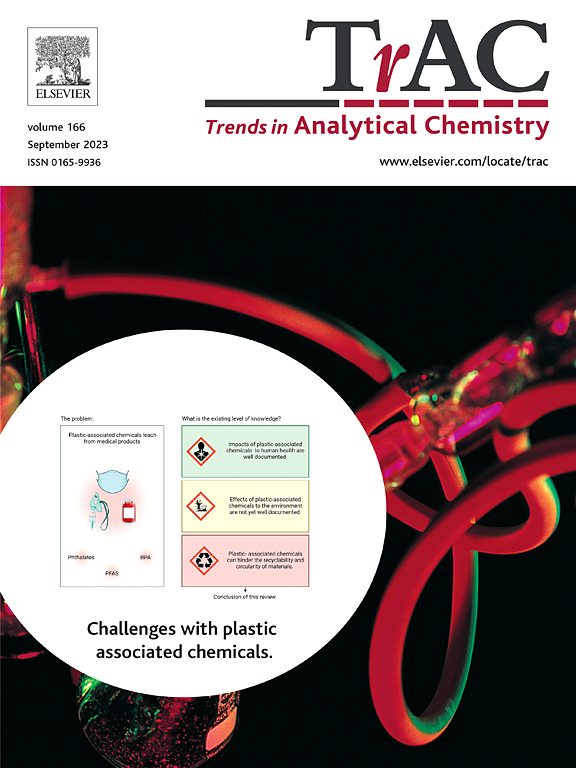金纳米材料衍生的免疫传感和食品安全比色信号策略
IF 11.8
1区 化学
Q1 CHEMISTRY, ANALYTICAL
引用次数: 0
摘要
背景食品行业面临着变质和污染的巨大挑战,导致食品安全事件频发,经济损失巨大。范围和方法比色免疫传感器因其特异性、成本效益、便携性和信号解读的简易性而备受青睐。金纳米材料(AuNMs)具有优异的光学特性、亲和力和催化活性,可实现准确可靠的检测,因此被广泛应用于比色免疫传感器中。然而,对于传统胶体金来说,实现准确可靠的检测仍然是一项重大挑战。针对这一问题,研究人员提出了各种有效的改进策略,同时保留了 AuNMs 的固有优势。本研究探讨了基于 AuNMs 的固有和活化比色免疫传感方法,重点关注其在食品安全监控中的应用。具体而言,本综述首先对直接来自纳米标签本身的信号策略进行了分类和总结,然后对催化反应进行了详细介绍。此外,它还探讨了基于 AuNMs 的比色免疫分析中遇到的挑战,并概述了未来的发展方向,为设计适合食品行业特定需求的传感模式提供了一种新方法。本文章由计算机程序翻译,如有差异,请以英文原文为准。
Gold nanomaterials-derived colorimetric signaling strategies for immunosensing and food safety
Background
The food industry faces significant challenges from spoilage and contamination, leading to frequent food safety incidents and substantial economic losses. As a result, the development of sensors capable of detecting foodborne contaminants has become increasingly critical.
Scope and approach
Colorimetric immunosensors are particularly favored for their specificity, cost-effectiveness, portability, and ease of signal interpretation. Gold nanomaterials (AuNMs) are widely employed in colorimetric immunosensors owing to their superior optical properties, affinity, and catalytic activity, which enable accurate and reliable detection. However, achieving accurate and reliable detection remains a significant challenge for traditional colloidal gold. To address this issue, researchers have proposed various effective improvement strategies while preserving the inherent advantages of AuNMs. This study investigates both intrinsic and activated colorimetric immunosensing methods based on AuNMs, with an emphasis on their application in food safety monitoring. Specifically, this review first categorizes and summarizes signal strategies derived directly from the nanolabels themselves, followed by a detailed introduction of catalytic reactions.
Key findings and conclusions
This review offers valuable insights into enhancing current colorimetric detection methods and establishes a solid foundation for the development of diversified “colorimetric + other signals" immunoassays. Furthermore, it addresses the challenges encountered in AuNMs-based colorimetric immunoassays and outlines future development directions, providing a novel approach to designing sensing modes tailored to the specific needs of the food industry.
求助全文
通过发布文献求助,成功后即可免费获取论文全文。
去求助
来源期刊

Trends in Analytical Chemistry
化学-分析化学
CiteScore
20.00
自引率
4.60%
发文量
257
审稿时长
3.4 months
期刊介绍:
TrAC publishes succinct and critical overviews of recent advancements in analytical chemistry, designed to assist analytical chemists and other users of analytical techniques. These reviews offer excellent, up-to-date, and timely coverage of various topics within analytical chemistry. Encompassing areas such as analytical instrumentation, biomedical analysis, biomolecular analysis, biosensors, chemical analysis, chemometrics, clinical chemistry, drug discovery, environmental analysis and monitoring, food analysis, forensic science, laboratory automation, materials science, metabolomics, pesticide-residue analysis, pharmaceutical analysis, proteomics, surface science, and water analysis and monitoring, these critical reviews provide comprehensive insights for practitioners in the field.
 求助内容:
求助内容: 应助结果提醒方式:
应助结果提醒方式:


